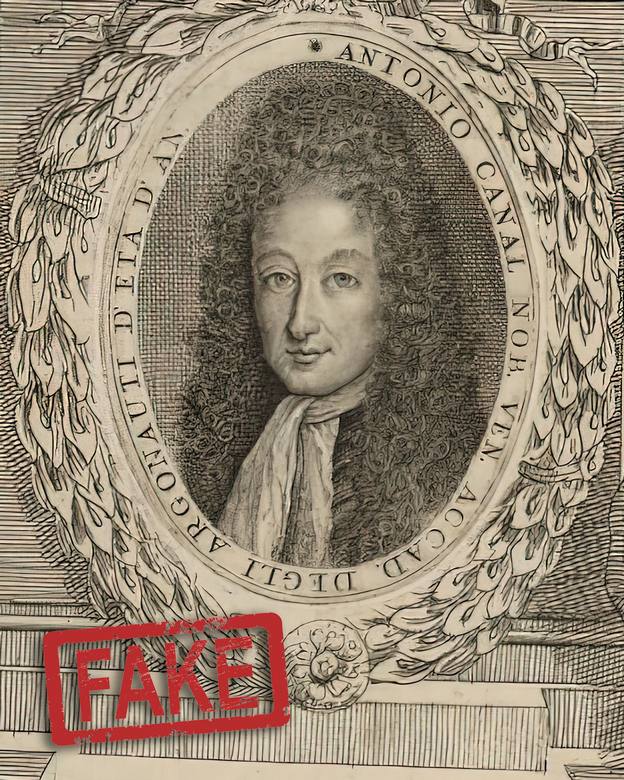
Canaletto's fake portrait
The wrong Antonio Canal:
just one more confusion for historians
There is a portrait of a certain Antonio Canal that can be found in the book published in 1894 by Adrien Moureau that is presented - although with some very substantiated doubts about its authenticity by the author - as a possible portrait of Canaletto.
But it has nothing to do with Canaletto the painter, and is a fake, or simply a coincidence.
I have been doing extensive researches, and it's definitely a case of homonymy.
The Antonio Canal in Moureau's book (page 42), who is associated to this Accademia Cosmografica degli Argonauti is simply another person, who lived at the beginning of the XVII century (an educated guess could be 1600-1660).
He was a Procuratore di S.Marco - which was quite an important position - but there is nothing related to the Antonio Canal, (also known as) the Canaletto, the painter.
It is just the same family name, and possibly he may have been one of his ancestors - four generation earlier - Venice wasn't that big, after all.
Adrien Moureau's doubts
But also Adrien Moureau wasn't too sure about the truthfulness of this Canaletto portrait. And in fact he makes a comparison in his book with the only recognized Canaletto portrait: the engraving done by Visentini, from the drawing of Giovanni Battista Piazzetta:
"Dans le second [portrait], assez dissemblable, les traits se sont émaciés, l’expression générale s’est alanguie et le regard semble voilé d’une certaine mélancolie; cette fois la tête est couverte d’une énorme perruque alors en usage à Venise; ce petit médaillon, sans nom de graveur, nous apprend aussi que notre artiste fut membre de l’Académie des Argonautes."
"In the second [portrait], rather dissimilar, the features have become emaciated, the general expression has become languid, and the eyes seem veiled with a certain melancholy; this time the head is covered with an enormous wig then in use in Venice; this small medallion, without the name of the engraver, also tells us that our artist was a member of the Academy of Argonauts."
Accademia degli Argonauti
The Academia Cosmografica degli Argonauti was composed of Nobles from Venezia, Paris, Roma, Bologna, Firenze, Siena, Napoli , Germany, and Poland, who would sponsor the Vincenzo Maria Coronelli project of making maps of the cosmos and painted globes that range from science to superstition, Astrology, mysticism ...
But here are the facts, let's follow the trail:
- The portrait in question is a medallion that had been very likely been made to be used on one of those etchings - Ritratti di Membri dell'Accademia degli Argonauti - we can find at the Galleria Corsini in Rome.
- In the book the medallion is flipped left/right, maybe because it was in the process of being made into a stamp, but ended up unused: the writing on the medallion's border reads: "ANTONIO CANAL NOB. VEN. ACCAD. DEGLI ARGONAUTI D'ETA D'AN" (Antonio Canal Noble Venetian Accademia degli Argonauti of Age Years ...). No age date.
- The list of "associates" to the Accademia is referred, in the book "Impresa dell'Accademia Cosmografica degli Argonauti - catalogo degli associati ... edited in 1687.
The Antonio Canal name is there, and most of the associates I have researched had lived in the XVII century, around 1620-1680s: Canaletto hadn't been born yet.
- I have checked in the book "CRONOLOGIA UNIVERSALE, Che facilita Lo Studio di qualunque Storia ..." - 45 volumes - prepared by Vincenzo Coronelli, and printed in 1707, in which there is reference to all the people that have participated in the "Academia Cosmografica degli Argonauti project".
- Sure enough a certain Antonio Canal (Cavalier) is there, having kept the position of "Procuratore di San Marco" from November 9, 1646 to October 30, 1650, and had been substituted by a certain Girolamo Foscarini (Cavalier).
Even though the period calculation of 4 years, 1 Month, 20 Days is not correct, the logic holds tight.
- In any case, the Accademia Cosmografica degli Argonauti was dissolved at the death of his creator (Padre Vincenzo Coronelli) in 1718.
Canaletto was - at this date - a 21 years young wannabe painter, who, in 1719,will be
" ... excommunicating the dramatic Poets because of their inconsistency ...".
Vincenzo Maria Coronelli: [1687] - Catalogo degli associati dell'Accademia degli Argonauti - page 28 with Antonio Canal name at the bottom
![Vincenzo Maria Coronelli: [1707] - Cronologia Universale - Famiglie Patrizie, Venezia - page 474](../images_db/Coronelli--1707--x031a-Cronologia-606_1-famiglie-patrizie_1b.jpg)

Vincenzo Maria Coronelli: [1707] - Cronologia Universale - Famiglie Patrizie, Venezia - page 474
![Vincenzo Maria Coronelli: [1707] - Cronologia Universale - Procuratori di S.Marco - Page Header - page 476](../images_db/Coronelli--1707--x031b-Cronologia-612_1_header.jpg)

Vincenzo Maria Coronelli: [1707] - Cronologia Universale - Procuratori di S.Marco - Page Header - page 476
![Vincenzo Maria Coronelli: [1707] - Cronologia Universale - Procuratori di S.Marco relative to Antonio Canal - page 479](../images_db/Coronelli--1707--x031d-Cronologia-617b3a.jpg)

![Adrien Moureau: [1894] - Les Artistes Célèbres - Antonio Canal](../images_db/Adrien-Moureau-1894--x021-Les-Artistes-Celebres--Antonio-Canal-cover.jpg)
![Adrien Moureau: [1894] - Les Artistes Célèbres - Antonio Canal - page 42](../images_db/Adrien-Moureau-1894--x022-Les-Artistes-Celebres--Antonio-Canal-page-42-fake1.jpg)


![Vincenzo Maria Coronelli: [1687] - Catalogo degli associati dell'Accademia degli Argonauti - page 21 - Cover](../images_db/Coronelli-1697--x032-catalogo-argonauti-pag21.jpg)
![Vincenzo Maria Coronelli: [1687] - Catalogo degli associati dell'Accademia degli Argonauti - page 27 - Venetian Associates](../images_db/Coronelli-1697--x032b-catalogo-argonauti-pag27.jpg)
![Vincenzo Maria Coronelli: [1687] - Catalogo degli associati dell'Accademia degli Argonauti - page 28 with Antonio Canal name at the bottom](../images_db/Coronelli-1697--x032c-catalogo-argonauti-pag28.jpg)
![[1708] - Portrait of Coronelli Vincenzo Maria, P Magister Vincentius Coronelli Venetus](../images_db/x030-P_Magister_Vincentius_Coronelli_Venetus_-_Coronelli_Vincenzo_Maria_1708.jpg)
![Vincenzo Maria Coronelli: [1707] - Cronologia Universale](../images_db/Vincenzo-Maria-Coronelli-1707--x031-Cronologia-Universale-cover-gp.jpg)